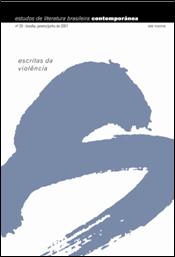Cultura de massa:
o caso José Agustín
Abstract
Muitas narrativas escritas na América Latina na última década recriam, na ficção, situações cotidianas nas metrópoles, onde se pode observar uma presença cada vez mais intensa da cultura
de massa. Produtos que podem ser ligados tanto ao campo artístico ”“ como filmes e músicas ”“ quanto a muitos outros ”“ relacionados aos campos da publicidade e do marketing ”“ são claramente postos em muitas das narrativas contemporâneas. Em De perfil, publicado por José Agustín, em 1966, muitos dos elementos da cultura de massa aparecem por meio de um texto
irônico, fragmentado, cercado de vozes de muitos segmentos sociais. Essa obra assegurou uma posição de destaque ao autor na jovem geração que inaugurou o pós-modernismo na literatura mexicana.
Downloads
References
AGUSTÃN, José. De perfil. México (DF): Editorial Planeta, 1999.
BERMAN, Marshal. Tudo que é sólido desmancha no ar. São Paulo: Companhia das Letras, 1986.
COELHO, Marcelo. Crítica cultural: teoria e prática. São Paulo: Publifolha, 2006.
COUTINHO, Eduardo. “O pós-modernismo e a literatura latino-americana contemporânea”, em . Literatura comparada na América Latina. Rio de Janeiro: Ed. UERJ, 2003.
DUARTE, Rodrigo. Teoria crítica da indústria cultural. Belo Horizonte: UFMG, 2003.
ECO, Umberto. Apocalípticos e integrados. 6ª ed. São Paulo: Perspectiva, 2001.
HUTCHEON, Linda. Teoria da paródia. Lisboa: Edições 70, 1996.
HUYSSEN, Andreas. “Mapeando o pós-moderno”, em et al. Pósmodernismo e política. Rio de Janeiro: Rocco, 1991.
LEE, Joong Kim. Cultura y sociedad de México en la obra de José Agustín. Guadalajara: Universidad de Guadalajara, 2000.
LIMA, Luiz Costa. Demanda dispersa. Rio de Janeiro: Francisco Alves, 1981.
WILLIAMS, Raymond L. The postmodern novel in Latin America. New York: St Martin’s Press, 1996.
______e RODRÃGUEZ, Blanca. La narrativa posmoderna en Mexico. Xalapa (México): Universidad Veracruzana, 2002.
Downloads
Published
How to Cite
Issue
Section
License
Authors who publish in this journal agree to the following terms:
a) The authors maintain the copyright and grant the journal the right of first publication, the work being simultaneously licensed under the Creative Commons Attribution License-Non Commercial 4.0 which allows the sharing of the work with acknowledgment of the authorship of the work and publication this journal.
b) Authors are authorized to enter into additional contracts separately, for non-exclusive distribution of the version of the work published in this journal (eg publish in institutional repository or as a book chapter), with authorship recognition and publication in this journal.
c) Authors are allowed and encouraged to publish and distribute their work online (eg in institutional repositories or on their personal page) after the editorial process, as this can generate productive changes, as well as increase the impact and citation of published work (See The Effect of Free Access).
d) The authors of the approved works authorize the magazine to, after publication, transfer its content for reproduction in content crawlers, virtual libraries and the like.
e) The authors assume that the texts submitted to the publication are of their original creation, being fully responsible for their content in the event of possible opposition by third parties.


